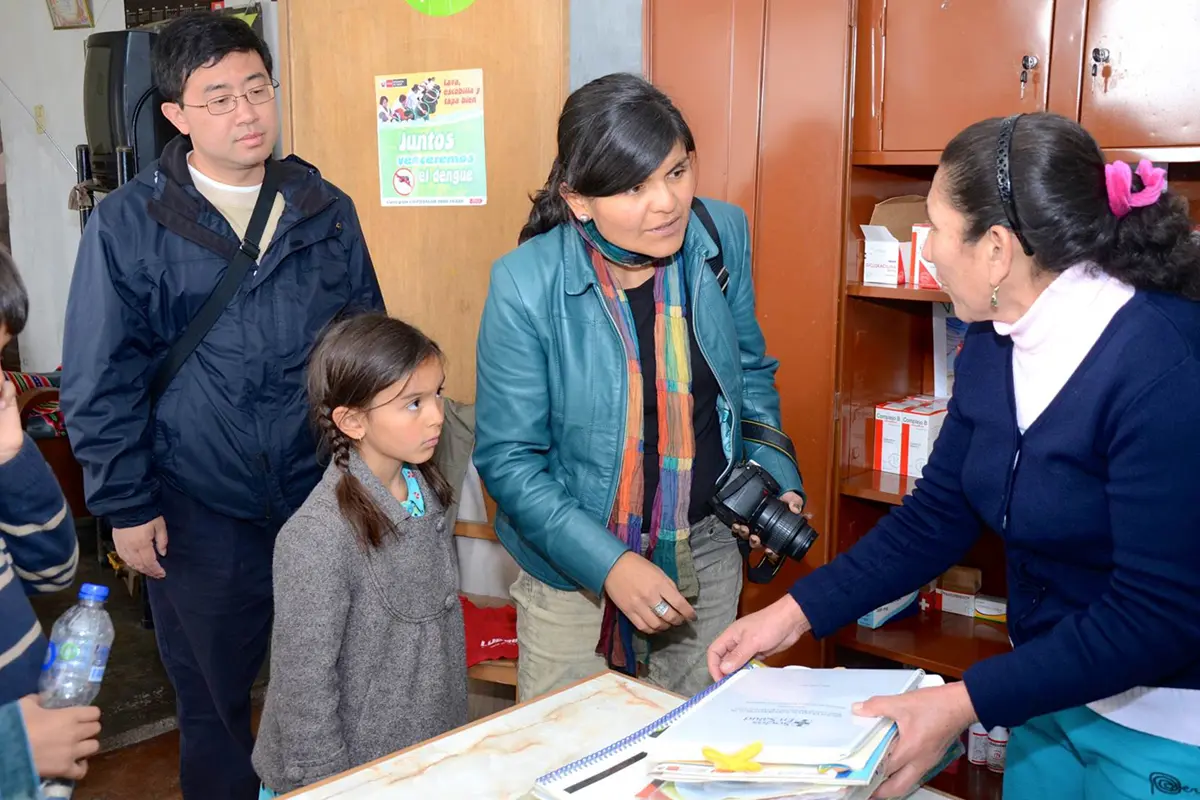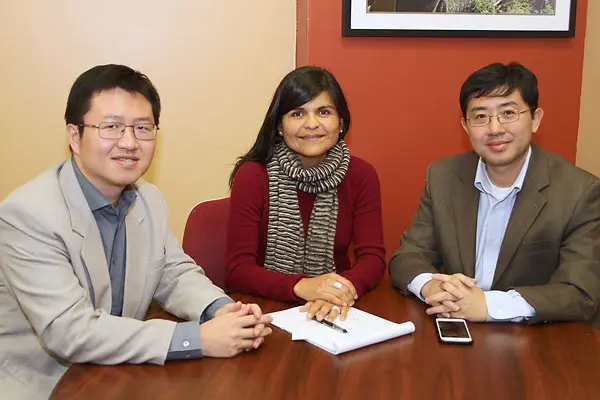Project Is Funded by $1.3M Grant from NIH, NSF

Assoc. Profs. Benyuan Liu and Maria Julia Brunette talk to a health-care worker at a TB clinic in Carabayllo, near Lima, Peru, during their visit in August 2013.
12/08/2015
By Edwin L. Aguirre
A team of researchers led by UMass Lowell faculty is using smartphone technology to help improve the diagnosis of people afflicted with tuberculosis, or TB, a chronic and infectious disease that disproportionately affects poor and marginalized communities. Last year, 9.6 million people around the world became sick with TB, and 1.5 million died of TB-related complications, according to a report by the World Health Organization (WHO).
“This is unacceptable, considering TB is curable and preventable,” says Assoc. Prof. Maria Julia Brunette of the College of Health Sciences’ Department of Work Environment.
 Brunette is collaborating with computer science Assoc. Prof. Benyuan Liu and Asst. Prof. Yu Cao to develop a mobile device-based, computer-aided system for TB screening that would reduce wait times for patients by speeding up the diagnosis so they can start the treatment right away. Brunette, Liu and Cao are the principal investigators for the project, which is being funded by a four-year, $1.3 million grant from the National Institutes of Health (NIH) and the National Science Foundation (NSF) through the interagency program Smart and Connected Health. A group of Peruvian physicians from Partners in Health Peru (Socios en Salud, or SES) are also collaborators in this project. The SES has decades of experience working in the fight against TB and is well-known among the public health community in Peru.
Brunette is collaborating with computer science Assoc. Prof. Benyuan Liu and Asst. Prof. Yu Cao to develop a mobile device-based, computer-aided system for TB screening that would reduce wait times for patients by speeding up the diagnosis so they can start the treatment right away. Brunette, Liu and Cao are the principal investigators for the project, which is being funded by a four-year, $1.3 million grant from the National Institutes of Health (NIH) and the National Science Foundation (NSF) through the interagency program Smart and Connected Health. A group of Peruvian physicians from Partners in Health Peru (Socios en Salud, or SES) are also collaborators in this project. The SES has decades of experience working in the fight against TB and is well-known among the public health community in Peru.
The team’s initiative, called “mHealth,” aims to design a socio-technical system solution for TB diagnosis based on novel image processing, machine learning and mobile-computing techniques.
“The social and human aspects of the current healthcare work system in Lima will be analyzed via health systems engineering analyses, and the results will be incorporated throughout the system’s design and deployment. The technical component of mHealth will be the smartphone-based, computer-aided TB screening tool. Our ultimate goal is to achieve a socio-technical integration that is feasible and sustainable,” explains Brunette.
The mHealth study will be conducted in Carabayllo, a densely populated district north of Lima, the capital of Peru. The country has one of the highest TB incidence rates in Latin America, accounting for 12 percent of the total number of cases. It is also among the top eight countries in the world with multidrug-resistant tuberculosis.
The goal of the project is to provide a tool for nurses and health-care workers at remote TB clinics to capture, process and analyze images of film chest X-rays brought by the patients. The tool consists of a smartphone or tablet that is connected to cloud-computing servers with special programs or algorithms that will automatically analyze and enhance the images so any telltale signs of active TB would show up more clearly.
“The algorithm on the cloud will also examine, screen and classify the images, assigning scores to each case and posting red flags as needed,” explains Liu.
Using the existing cellular or Wi-Fi network, the images are then transmitted to a server running data analytics in the cloud, where doctors in the city can access the X-ray images, confirm the diagnosis and send results back to the mobile-device user. This process can potentially reduce wait times from weeks to days.
“Automatic screening for TB in chest radiographs is still a challenging task and an open research problem,” notes Cao. “The cutting-edge computing techniques we are actively developing in this project have huge potential to transform the field.”
If successful, the project will eventually be applied in low- and middle-income communities in the United States and elsewhere. In 2014, more than 9,400 TB cases were reported to the U.S. Centers for Disease Control and Prevention from across the country, with California, Texas, New York and Florida accounting for 51 percent of the total cases.
“Reducing the delay in TB diagnosis is critical in mitigating disease,” says Brunette. “It can minimize the transmission and the reproductive rate of the TB epidemic.”
In addition to UMass Lowell and Partners in Health Peru, other members of the team include researchers from Boston University School of Medicine and Harvard Medical School as well as local health experts and government and non-government organizations in Peru, including representatives from the Peru National TB program, the Peruvian Ministry of Health (MINSA), the Mayor’s Office in Carabayllo and pulmonologist Epifanio Sanchez and biomedical informatics expert Walter Curioso.
Making a Difference in People’s Lives
Brunette and Liu visited the slums of Carabayllo in 2013 to gain firsthand knowledge of the TB situation in the country and to talk to doctors and local health-care workers.
“Efforts to eliminate the TB epidemic are challenged by the persistent social inequalities in health care, the limited number of local health-care professionals and the weak health-care infrastructure found in resource-poor and socially excluded communities,” says Brunette, who also directs the UMass Lowell-WHO Collaborative Center and the International Partnerships with Peru.
In addition to the software tools, the team is also developing a large-scale, well-annotated database of chest X-ray images that will be publicly available.
“The database and algorithm will be used as an educational tool to train future radiologists and technicians and to track the progress of the treatment,” says Cao. “The smartphone’s TB diagnostic system will also be made available as an open-source software package.”
“This high-impact research represents a great combination of mobile health technology, understanding of the international social context and interdisciplinary collaboration across the College of Health Sciences and the Kennedy College of Sciences,” says Vice Provost for Research Julie Chen, who provided the seed grant for the project in 2013.
